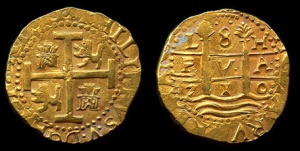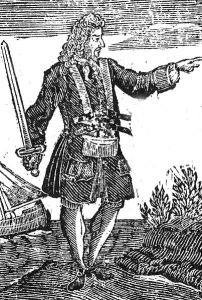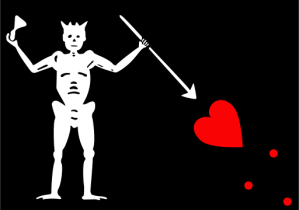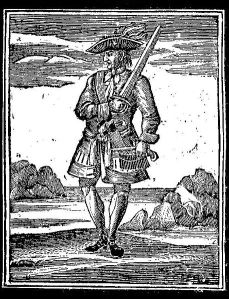Having already posted about the two famous female pirates, Anne Bonny and Mary Read, it’s time to look at their pirate captain, “Calico Jack” Rackam. In many ways, he’s typical of pirates in the Golden Age of Caribbean piracy, roughly 1713-1730.

The guy with the overextended lower jaw is Carlos II of Spain, whose inability to father an heir began the War of the Spanish Succession
As with most pirates, we know very little about the early life of Jack Rackam. He was probably English, and I’d guess at a birthdate around 1690. Best guess, based on his subsequent career, is that he had been at sea, possibly as a privateer, in the years before the Treaty of Utrecht in 1713 ended the War of the Spanish Succession. The end of the war ended large-scale privateering, for the European powers were at peace. They even reduced the size of their navies. Hence there were a lot of unemployed sailors milling around the Caribbean, just looking for decent employment. And if they had been privateers, they wouldn’t have been too averse to engaging in a little violence to make some money, and a lot more violence if a substantial amount of treasure was involved.
Well, lucky for them, a Spanish treasure fleet sank in shallow waters off the coast of Florida on June 30, 1715. All that lovely silver, just waiting for someone to salvage it. In November, 1715, the governor of Jamaica dispatched Captain Henry Jennings to go to Florida and dredge up some of the silver. Jennings arrived at the site of the shipwrecks, only to find that the Spanish government had already sent a salvage crew, which had been working on the wrecks for months.
At this point, Jennings, shall we say, exceeded his orders. Instead of just leaving, which would have been the proper course, or competing with the Spanish in salvaging the wrecks, which would have been in accordance with his orders if illegal, he attacked and plundered the Spanish camp. Why waste time diving for treasure, when you can just kill some soldiers and take it? He came away with 60,000 pieces of eight. And then he went back again in January, 1716, attacked the Spanish again, and this time picked up 120,000 pieces of eight.
But Jennings’s success came at a price. The Spanish complained to the British, and the British government disavowed Jennings, making him a pirate.
Jennings needed someplace to go, someplace where he and his crew could spend their new wealth, trade for new ship supplies, and use as a base for further plundering. Naturally, the Spanish and British colonies were closed against him, and the French and Dutch didn’t want him either. Legitimate commerce was now more important than piracy to the European powers. What Jennings needed was an island not ruled by any of the colonial powers, a place that would welcome pirates.
As it turned out, there was such a place: New Providence in the Bahamas. Officially, the Bahamas were ruled by the British. But the Spanish had raided the islands during the late war, destroying British authority there. And in November, 1715, a pirate named Benjamin Hornigold sailed into the harbor, occupied the old fort, and established control of the island.
Recent popular television series, such as Black Sails and Crossbones, have made New Providence into a tropical paradise, a prosperous pirate republic in which wealthy pirates can live in sumptuous mansions, while lesser criminals can patronize elegant whorehouses that would do credit to New Orleans circa 1900. The truth was a lot less elegant. New Providence had been a small, almost ruined settlement when Hornigold arrived, and the influx of pirates and traders meant an awful lot of tents and ramshackle structures had to be put up in a hurry. The place more resembled a goldmining camp than a resort town.
Jennings took up residence in this lawless bustling trading port. One of his subordinates was a man named Charles Vane. And probably by this time, one of Vane’s crew was Calico Jack.
New Providence became a pirate’s haven, and perhaps even a pirate’s heaven, for two years. No doubt Jennings, Vane, and Rackam enjoyed their time there. And then in December, 1717 the news came that Britain was going to reestablish control of the island. A former privateer named Woodes Rogers was going to be the new governor. He would come with ships and guns. And he would also come with a royal pardon. Any pirate that foreswore his lawless ways would be forgiven his former crimes. Any pirate that did not, or any pirate who did and then broke his word, would be hunted down and executed.
So the pirates debated among themselves whether to accept the pardon or not. Jennings probably hadn’t wanted to be a pirate, so he was all for the pardon. So was Hornigold. And so, it turned out, were a majority of the pirates on New Providence. But not all.

On Black Sails, Vane is a violent man, Rackam a sort of 18th c. pirate PR man, and Bonny is a psycho-killer
Charles Vane was one of the die-hards. He recruited a crew of other pirates, including Calico Jack, who wanted to continue on as pirates. And in one of those acts of bravado that endeared pirates to the public imagination, Vane waited until after Rogers arrived on July 26, 1718 to take his leave, in spectacular fashion. He filled a captured French ship with combustible materials, set it on fire, and sent it toward the British warships in the harbor. It failed to destroy the warships, but it caused a lot of havoc, especially when its loaded cannons blew up. And in the confusion, Vane escaped in his ship Ranger.
Vane was captain, while Calico Jack was on board the Ranger as quartermaster. These titles don’t quite mean what they do today. As captain, Vane’s authority was absolute in combat situations, and officially nonexistent otherwise. The quartermaster managed the ship’s supplies and treasury, making sure everyone got their fair share, and represented the crew to the captain. While technically subordinate to the captain, in a lot of ways the quartermaster was even more powerful. However, both officers could be voted out of office by the crew.
If it wasn’t clear enough, Vane proved himself a pirate by seizing a sloop from the British island of Barbados two days later. And so he became a marked man, the pirate who had openly defied Woodes Rogers and the British Navy. A useful reputation for terrifying merchant ships into surrendering without a fight, but a bad one if he were to be caught.
And with New Providence lost to the pirates, Vane and his crew had to live on what they captured. Trade goods were useless to them, until they found a new friendly port. No, what they needed were supplies: food, clothing, ship stores, medicine. Most ships only carried enough gold and silver coin for trading purposes, and while it was nice to seize, it wouldn’t make the pirates rich.
They did well enough for a while. But tension arose between the crew of the Ranger and the Barbadian sloop they had seized and manned. The pirates on the sloop felt they were getting short-changed, and resolved to go off on their own. Vane naturally took this as an insult, and chased the sloop until it took refuge in shallow waters along the South Carolina coast. The sloop’s crew then appealed for a pardon to the authorities, who granted it. At a stroke, Vane was deprived of a significant part of his strength.
That was always the danger with pirate crews. They were democratic in the most basic sense: you couldn’t do anything without a majority of the crew on the ship backing you up. And that made pirate fleets rare, for each ship’s captain was jealous of his authority and could survive only with the backing of his crew.
You’d think Vane would have learned from the sloop’s defection. And if not from that, well, from his get-together with the pirate Blackbeard. The two captains met up in September, 1718, and spent some time in a continual drunken party. It was a great party, but the two captains made no common cause. Blackbeard had an under-the-table arrangement with the governor of North Carolina, and stayed, while Vane sailed north to Long Island.
And then Vane’s downfall began. He challenged what he thought was an armed merchant ship. Instead, it turned out to belong to the French royal navy, and made it clear it was quite willing to fight it out with Vane. Mindful that the French warship outgunned him, Vane decided to run for it. He had absolute authority as captain to make that decision. But the moment they escaped the French, Rackam as quartermaster called for a vote to depose Vane on the grounds he was a coward, and it carried. Rackam became the new captain of the pirate crew on November 24, 1718.
Vane and the minority of the crew who stuck with him were given a small sloop, which they sailed into the Caribbean. After one misadventure after another, Vane first lost his ship and then was taken prisoner by an honest ship captain who recognized him and transported him to Jamaica, where he was thrown into prison for a year. He was tried in Jamaica on March 22, 1721, found guilty of piracy, and hanged a week later.
Rackam was now captain of a pirate ship. In his General History of the Robberies and Murders of the Most Notorious Pirates (1724), Capt. Charles Johnson offers an account of what Rackam did next, and also accounts of Anne Bonny and Mary Read. They’re colorful accounts. But stripped of the more romantic details, what they really amount to is that Rackam and his fellow pirates survived. They escaped capture. They took several prizes. But none of the prizes made them rich.
Maybe that’s the reason Rackam petitioned for the King’s Pardon and was accepted in May of 1719, and so ceased to be a pirate. But that probably wasn’t his only reason. For war had broken out again between Britain and Spain in December, 1718, and the British government decided it was desperate enough for sailors to pardon some more pirates so they could serve as privateers. Kind of short-sighted of the British government, since the war was wrapped up with a peace treaty in February, 1720.
So let’s give Rackam some points for being clever. It was not the first time. Taking the ship away from Vane was probably the first. And Johnson mentions an episode where Rackam’s ship got trapped behind an island by a Spanish coast guard ship which was accompanied by a prize sloop the coast guard had taken earlier. Rackam waited until nightfall, loaded his crew into a boat, quietly rowed it over to the prize, boarded and seized it, and then used it to escape.
But Rackam’s cleverness had limits. With the coming of peace, Rackam was out of a job as a privateer (assuming he had become one). So he fell back on his old trade, and by August, 1720, he was back at sea as a pirate. Given his past track record, this wasn’t a wise move; worse, it certainly meant he’d never get another chance at a pardon. Still, he had Anne Bonny as his mistress with him. And Mary Read was with him, though they were not lovers. Sadly, the one thing that wasn’t with him was luck. His men took only a few small boats before being pursued and captured by an armed merchant vessel sent out to hunt for them. They were brought to trial in Jamaica on November 16, 1720. Rackam, along with most of the crew, was found guilty and condemned to death. Probably the death sentence hurt him less than being scorned as a coward by Anne Bonny while he awaited execution, which occurred the next day.
Apart from his association with Anne Bonny and Mary Read, Rackam’s career was too typical of pirates in his time. They were privateers when they could be and pirates when they could not. Their prizes could keep them fed, clothed, and drunk, but gave them neither wealth nor safety. Becoming a leader put you at risk of your crew turning against you. And by 1720, the odds were good that you’d be captured and hanged before too long.






“At a stroke, VanE was deprived…”
LikeLike
Got it! Thank you.
LikeLike
Lovely, informative article! Anne Bonny was one tough woman! Did she go back to pirating or was she hanged for being a pirate? I’m sorry, but I can’t remember and I must sadly admit it’s too late for me going back through a number of articles.
LikeLiked by 1 person
Hope you weren’t having a sleepless night! To answer your question, both Read and Bonny were convicted of piracy. However, they were both able to prove they were pregnant when the sentence was handed down, so the executions were stayed. Read died in prison before giving birth. Curiously, we do not know Anne Bonny’s fate at all. It probably would have been news if she had been hanged, She may have died in prison, or she may have been quietly released to go live with her father and his family.
LikeLike
Going off at a tangent, as is my wont . . . being well into fabrics I’d always thought ‘Calico’ when used as a sobriquet, in some way referred to the unbleached (unrefined) cotton fabric I know as calico (though I couldn’t figure how this applied). But not. It refers to any fabric with a REALLY rough nap—i.e. it means ‘Shaggy’. Reading this account, I understand how he came by the name, and it wasn’t for being a rough diamond,
LikeLiked by 1 person
Ah, now THAT is something I didn’t know, and neither do a lot of writers on Rackam. The usual guess is that he was smuggling textiles. But your explanation makes much, much more sense. Thank you!
LikeLike